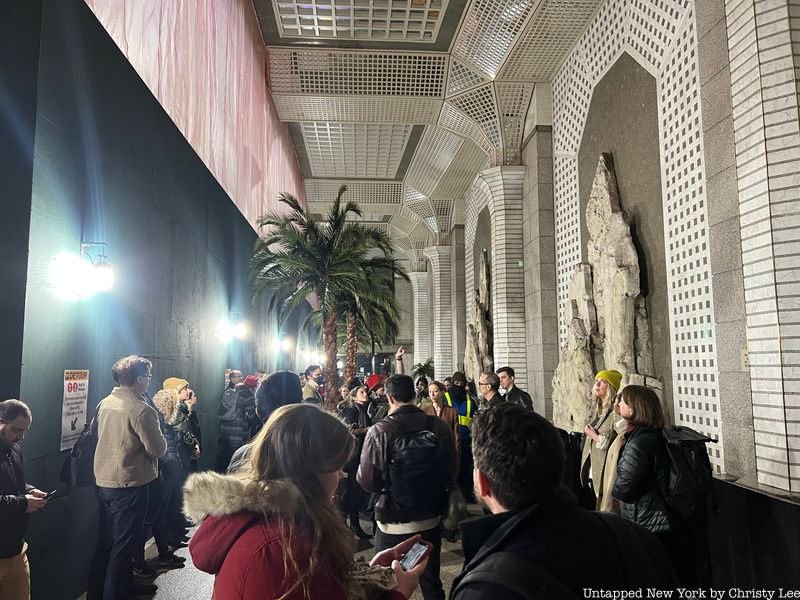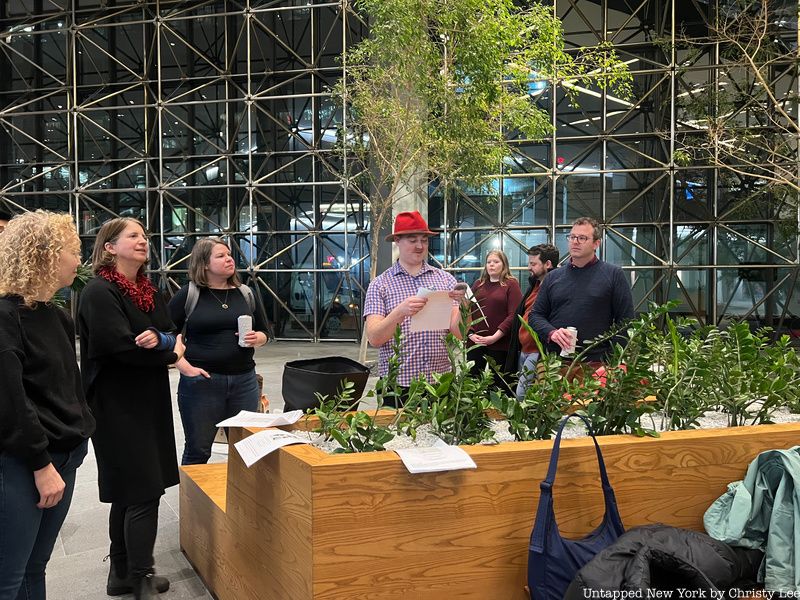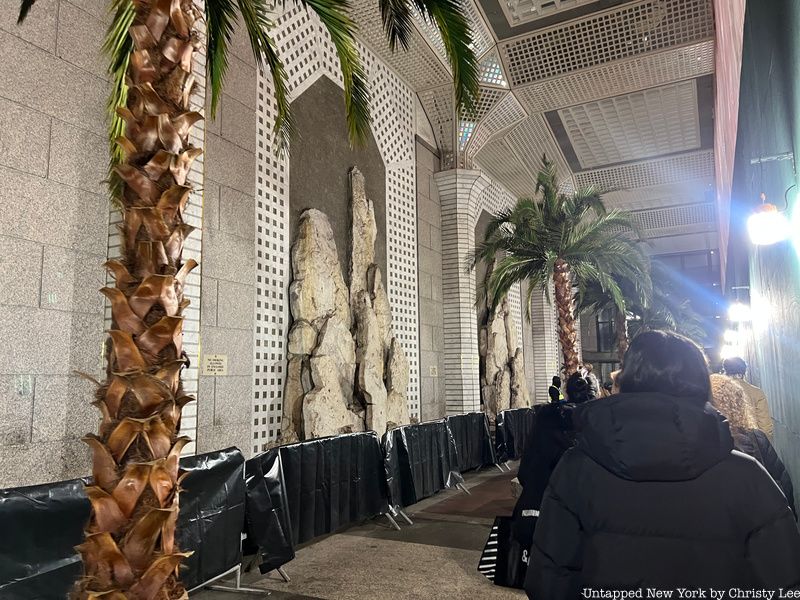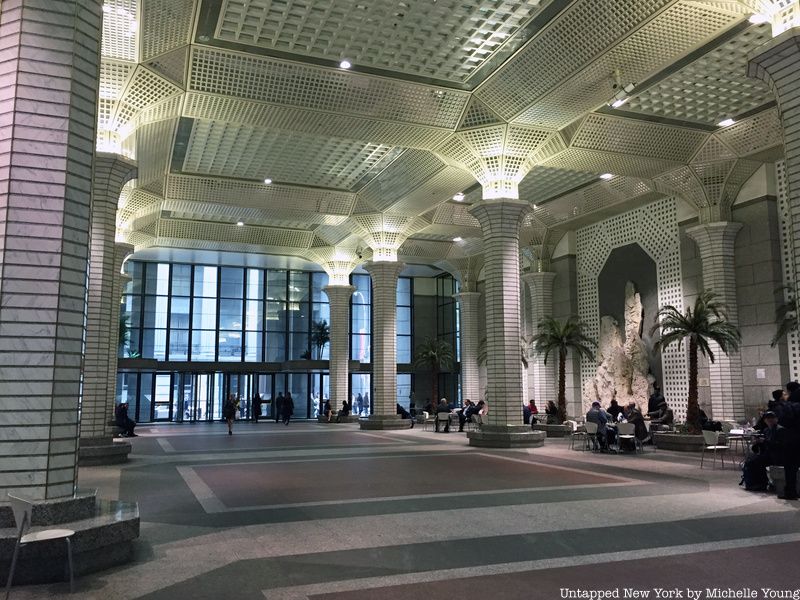100th Anniversary Great Nave Tour at the Cathedral of St. John the Divine
Celebrate the 1925 construction of the stunning nave inside the world's largest Gothic cathedral!


Dressed in black and their best interpretation of “cocaine chic” attire, a procession of New Yorkers walked through the Financial District on Thursday night to mourn the loss of the post-modern decor inside the atrium of 60 Wall Street, a privately owned public space (POPS). News of the atrium’s renovation has been met with resistance and regret by those in New York City’s preservation, architecture, and urbanist communities. Untapped New York joined the procession, hosted by the Municipal Art Society of New York (MAS), Open House New York, and Design Trust for Public Space, and spoke with New Yorkers who are sad to see this space go.

Construction has already begun at 60 Wall Street and barriers now block most of the space. The procession began at the entrance to the building where speakers from The Design Trust for Public Space, MAS, and OHNY shared a few quick words of introduction before leading the group through the only remaining accessible part of the atrium, a narrow passageway along the wall that runs between Pine and Wall Streets. “In a city that is chaotic, messy, and weird, we need these kinds of spaces,” rallied Matthew Clarke, Executive Director of Design Trust for Public Space.
The procession traveled to 180 Maiden Lane, home of another POPS, where guests shared anecdotes and stories of their connection to the atrium at 60 Wall Street. Urban planner Jack Darcey shared his poem,The Pineapple POPS Elegy which described the scene of workers scuttling to work through “Miami on Wall Street” and grabbing “a few lines of cocaine, a respite from the rain.” Clarke remembered seeing the atrium of 60 Wall Street for the first time after moving to New York from Kentucky and realizing that he was in “the best city in the world. To have a moment like that is incredible and I never forgot it.”

Completed in 1989 with a design by Kevin Roche, John Dinkeloo, and Associates, 60 Wall Street is a 55-story glass office tower that incorporates design elements of post-modern, Greek revival, and neoclassical styles. Inside the atrium, visitors step into a double-height space clad in white. Ten octagonal columns wrapped in Carrara white marble tiles flare out at the top to meet a ceiling clad in latticed mirrors. Benches ring the bottom of the columns and white metal chairs and tables dot the space.
On the walls, the lattice motif continues. Abstract stone sculptures are framed by the borderline dizzying design. Palm trees sprout from planters that ring the atrium. The overall effect is that you are in a distinctly unique space that has been described as 80s cocaine decor. Some have said the space resembles a giant ice cream parlor while others say it has an Egyptian vibe.

“What I loved about this particular building is that it was a little bit over the top, but that was very much the 80s in New York,” said author and Untapped New York Insider Laurie Gwen Shapiro, “You kind of felt like you were in an episode of Miami Vice when you were having your little brown bag lunch.”
“I loved this atrium at 60 Wall” shares Untapped New York’s founder Michelle Young, “There was something magically bizarre and quintessentially New York about coming up out of the elevator from the subway station and emerging into this indoor public space. It reminded me of the design of a lot of New York City while I was growing up here in the 80s and 90s. In the 2000s I had a boyfriend who worked in Deutsche Bank and I’d post up in here sometimes.”
Not everyone loves the design, however. As evidenced by the failure to obtain interior landmark status for this space exemplifies, the preservation of post-modern architecture is a complex issue. While many preservationists and architects see the value in preserving post-modern buildings, it is often more difficult to garner support for these structures compared to those that fit into more widely appreciated aesthetics like Neo-Classical and Art Deco. Groups like Docomomo, MAS, and more are working to change this perception.
“We look at the architecture that we take seriously now from another era and it wasn’t always taken seriously in its own era,” says Shapiro. “People have a tendency to deride the 80s, but there was a distinct style and we might not have appreciated it at that moment, but as we look back, we might say ‘Hey, where are some indicative architectural landmarks that inform that time and place?'”

Since Deutsche Bank left the building in 2021, 60 Wall Street’s owner, real estate investment trust Paramount Group, has been searching for a new anchor tenant. The building is being renovated in hopes of drawing one in. Architecture firm Kohn, Pederson, Fox (KPF) has been tasked with the atrium’s new design.
KPF promises to “reimagine this urban room as an open, light-filled, and verdant place of life and activity.” Renderings for the new space show a grand staircase leading from the subway and a 100-foot-tall interior green wall that will stretch across the entire length of the block, making it the largest green wall in North America. The design calls for a new skylight, new eateries, and a reimagined facade for the lower floors.
“In a city that feels increasingly privatized, it’s so important to have places where people of all backgrounds can meet, can mingle, can sit, immerse themselves in a city,” says Kristin LaBuz, Executive Director of Open House New York, “I think when those public spaces have a certain design pizzaz, a certain look, a certain feel, a certain specialness about them, it elevates the entire experience of what it means to live in New York.”
While many bemoan the loss of this space for its architectural value, there is a practical use that will be missed as well. “As a tour guide that lobby was a safe haven in awful weather conditions and a real gem of Wall Street,” says Untapped New York’s Chief Experience Officer Justin Rivers. Though he admits “the lighting was awful,” this publicly accessible space served the dual purpose of providing shelter from the elements and “wowing” tourgoers with a space that is “a unique and quirky Wall Street secret.”
“Cities need spaces for respite, both exterior and interior, and 60 Wall was this unique and funky manifestation of a space for respite that is weather protected, transit connecting, multimodal, and that’s really special,” said Rebecca Macklis, Senior Manager, Strategic Initiatives at MAS.
It was a space, Shapiro remembers, where you could meet and talk with your fellow New Yorkers as you sought refuge from the hustle and bustle outside. “What public space looks like is different in every decade, but there was a little bit extra for the public here and that’s nice when that happens.”
Clarke, Macklis, and LaBuz all emphasized the necessity of POPS, like 60 Wall Street, and the community resources they provide, like public restrooms. “The Garden at 550 Madison is a beautiful space and one of the best parts is that it has a public bathroom,” says Abuz, “It has eight stalls and is super clean. The city needs more public facilities like that to be part of the infrastructure of public spaces.”
“Public infrastructure like libraries, recreation centers, comfort stations, those are all part of the tapestry of the ‘public realm’ that is supporting space to occupy and infrastructure to be healthy, safe, and welcome as a community,” explains Macklis, “and bathrooms are a really important part of that.”
Looking toward the future of creating more public space in the city, Clarke suggests taking it to the streets. “New York should start thinking about streets as public spaces, not just as places for cars to move and park,” he says, “We’ve taken a great step with outdoor dining, making it permanent, but there’s a lot of work to do. There are many more communities that need that asset. That’s the next frontier.”
The public space at 60 Wall Street will not be removed, but it will be out of commission while renovations are being done. To find an alternative POPS, check out this interactive map from MAS and Advocates for Privately Owned Public Spaces (APOPS).
We’ll have to wait and see if the new design of 60 Wall Street brings its own specialness to once again draw New Yorkers in, or if it will feel like just another corporate lobby. “People loved [60 Wall Street] in recent years because it was a last holdout,” Young says, “For a city to be vibrant, you have to keep some of the weird.”
Next, check out 10 Indoor Spaces in Manhattan for Your Own Urban Oasis
Subscribe to our newsletter